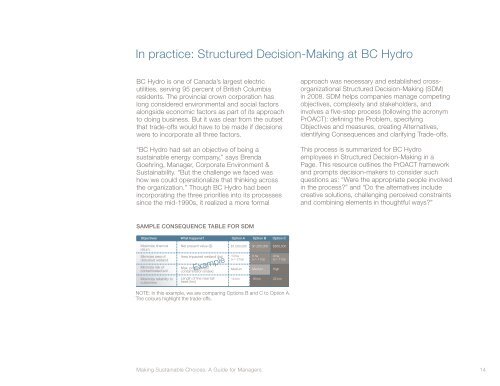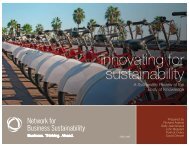A Guide for Managers - Network for Business Sustainability
A Guide for Managers - Network for Business Sustainability
A Guide for Managers - Network for Business Sustainability
Create successful ePaper yourself
Turn your PDF publications into a flip-book with our unique Google optimized e-Paper software.
In practice: Structured Decision-Making at BC Hydro<br />
BC Hydro is one of Canada’s largest electric<br />
utilities, serving 95 percent of British Columbia<br />
residents. The provincial crown corporation has<br />
long considered environmental and social factors<br />
alongside economic factors as part of its approach<br />
to doing business. But it was clear from the outset<br />
that trade-offs would have to be made if decisions<br />
were to incorporate all three factors.<br />
“BC Hydro had set an objective of being a<br />
sustainable energy company,” says Brenda<br />
Goehring, Manager, Corporate Environment &<br />
<strong>Sustainability</strong>. “But the challenge we faced was<br />
how we could operationalize that thinking across<br />
the organization.” Though BC Hydro had been<br />
incorporating the three priorities into its processes<br />
since the mid-1990s, it realized a more <strong>for</strong>mal<br />
SAMPLE CONSEQUENCE TABLE FOR SDM<br />
Objectives What happens? Option A Option B Option C<br />
Maximize financial<br />
return<br />
Minimize area of<br />
disturbed wetland<br />
Minimize risk of<br />
contaminated soil<br />
Maximize reliability to<br />
customers<br />
Net present value ($)<br />
Area impacted wetland (ha)<br />
Example<br />
Max. potential soil<br />
contamination (index)<br />
Length of line near tall<br />
trees (km)<br />
$1,000,000<br />
10 ha<br />
(+/- 2 ha)<br />
Medium<br />
14 km<br />
$1,250,000<br />
6 ha<br />
(+/- 1 ha)<br />
Medium<br />
16 km<br />
$850,000<br />
4 ha<br />
(+/- 1 ha)<br />
High<br />
22 km<br />
NOTE: In this example, we are comparing Options B and C to Option A.<br />
The colours highlight the trade-offs.<br />
approach was necessary and established crossorganizational<br />
Structured Decision-Making (SDM)<br />
in 2008. SDM helps companies manage competing<br />
objectives, complexity and stakeholders, and<br />
involves a five-step process (following the acronym<br />
PrOACT): defining the Problem, specifying<br />
Objectives and measures, creating Alternatives,<br />
identifying Consequences and clarifying Trade-offs.<br />
This process is summarized <strong>for</strong> BC Hydro<br />
employees in Structured Decision-Making in a<br />
Page. This resource outlines the PrOACT framework<br />
and prompts decision-makers to consider such<br />
questions as: “Were the appropriate people involved<br />
in the process?” and “Do the alternatives include<br />
creative solutions, challenging perceived constraints<br />
and combining elements in thoughtful ways?”<br />
Making Sustainable Choices: A <strong>Guide</strong> <strong>for</strong> <strong>Managers</strong> 14
















